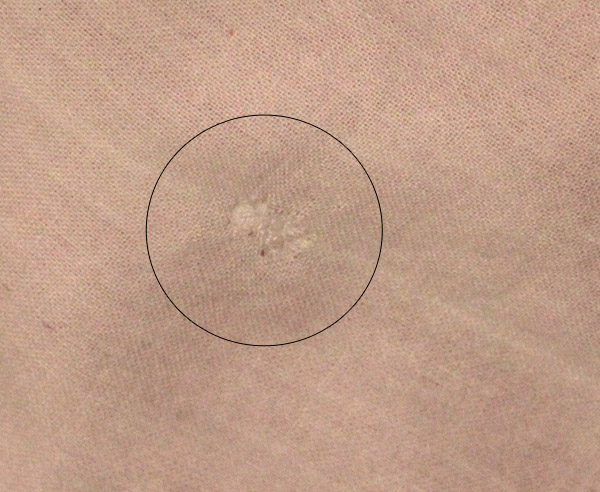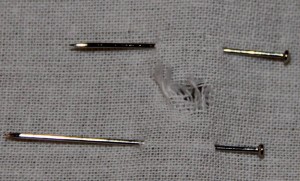Darn It
November 1st, 2011
The last time I wore my favorite chemise, I noticed yet another tiny rip. So after washing it, I hung it up to remind myself to mend it. That was in early September. Yesterday morning, right before I needed to wear it again, I finally got around to fixing the hole.
This one was too small to bother patching, so I decided to try my hand at darning. Lacking proper darning thread, and working against the clock, I did it rather sloppily. It’s also really hard to see when you’re weaving thread over other thread!

It may not be pretty, but it’s barely noticeable when it isn’t magnified. And it certainly does the trick! I need to learn more about darning — and of course, practice, practice, practice.
Not Again!
September 5th, 2011
Is it me? Is it my corset? Is it fate? What am I doing wrong? After only three more wearings, my (relatively) new chemise has another tiny tear.
It’s still just a little teeny rip — too small even to patch. I think I’ll try darning it this time. I suppose I should be glad I caught it so early. I only noticed because I decided to iron the chemise after its recent washing.
Sigh.
Stitch Not In Time
March 4th, 2011
Alright, alright, I’ve learned my lesson. Don’t make hand-sewn undergarments out of plain muslin. It’s oh, so tempting at less than $2 a yard (actually, it might as well be free — I’m still sewing through a bolt of white cotton muslin that my mother bought for me a decade ago). But look what happened to the chemise I made last year. I’ve only worn it three or four times too.

I think it might have ripped while I was fitting my new stays, twisting around this way and that, trying to slide into them without unlacing. Drat!
Always one to look for the silver lining, I have decided to use this as an excuse to practice my mending. Many of the manuals that I used to learn 19th-century hand-sewing have extensive sections on mending, including this catechism from England’s Finchley School manual Plain Needle-Work, in All Its Branches, 1852:
PATCHING.
Q. You have told me how you would manage a sheet, or any large coarse article; but should the linen, cotton, or whatever the material may be requiring a patch, be of a finer description, or printed in colours, how would you proceed?
A. I would cut the piece with which I intended to repair, exactly to a thread, and place it on the decayed or worn part, to a thread also, and on the right side; taking care, should the article have any pattern, to fix the patch so as to make the parts of the pattern correspond.
Q. “What next?
A. I then tack the patch on slightly, to keep it ia its place, and sew it at the edges in the manner of a hem, taking care to manage the corners neatly.
Q. And then?
A. Having made the cloth very flat and smooth, I carefully cut out the old piece on the wrong side, leaving sufficient to form a hem, the same as in patching a sheet.
Q. How do you manage to make the hem sit neatly at the corners?
A. I nick it a little, at each of the four corners, carefully turning-in the raw edges, making allowance for turning them in, and then proceed with the hem.
And just in case I’m tempted to put speed ahead of quality (especially since I need to rip out the armhole facing and hem it back down again over the patch):
“Patches should always be well shaped, and basted on perfectly even; a round, angular, or slanting patch, is the sure sign of a slut.”
The Girl’s Own Book, by Lydia Maria Child, 1853
Anyone having a sale on Kona cotton broadcloth? Or should I finally break into that stash of cream linen for my next chemise?

